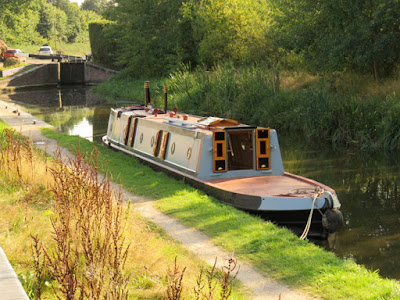 |
| Birmingham Main Line from the Library roof garden |
Are you still there, readers? If any of you are then you must be patient people and my apologies for being absent these past two weeks. Things have got in the way. Not least of them being locks.
We ended the last episode on the Worcester & Birmingham Canal just outside Worcester. This is a fiendish canal, of 58 locks and five tunnels in its 30 mile climb to Brum. What a challenge it must have been to the builders way back in 1798. And how profitable, they must have hoped, to justify that enterprise.
The early locks are like a warm-up routine for the main act: we went through a flight of seven, then one of six as well as the first, short tunnel. On the way we passed Stoke Wharf where a music festival was under way. The beards, long hair, jeans and black t-shirts in the pub meant just one thing – it was a heavy metal festival; wonderfully named 'Beermageddon'. Sadly the tickets were sold out, he said with tongue firmly in cheek.
 |
| Tardebigge where only radio aerials outnumber the locks |
The main act in our festival of locks was the Tardebigge flight: 30 locks, one after the other with no space for a halfway breather. They're not as bad as they sound: closely packed flights are easier to deal with than locks a few hundred yards apart. All the same, I was starting to flag after the first two dozen.
 |
| Fine views from the reservoir make the work worthwhile |
It's then you come upon the pretty feeder reservoir and your brain tells you this must be the top, even though the lock numbers don't add up. It isn't! Round the corner you go to find the final seven. Groan. And it was starting to rain. BTW there must be something about these locks – two of the canalside cottages are serious, and I mean serious, radio hams. Their houses are festooned with vast aerials; one even has some suspended from the mobile crane in his garden.
 |
| The Rolt-Aickman memorial above Tardebigge top lock |
We moored one below the top, then crossed the summit next day, stopping to view the plaque commemorating the spot where Robert Aickman met Tom Rolt, who'd been moored above the lock on Cressy during the war. From the meeting came the start of the movement to campaign for the resurrection of the canals.
A short run through two more modest tunnels to Alvechurch that day to re-stock at the village Co-op. (Be warned, it's a steep hill down into the village from the canal and an even steeper one back with a load of shopping).
Then came the big one; the 2700 yard long Wasts Hill Tunnel, straight enough to see right through but not especially pleasant with its dank, misty atmosphere and lack of ventilation. Two boats can pass in it, apparently, but it must be a squeeze.
You enter the tunnel from countryside and leave into the outer edges of Birmingham and the canal follows a vaguely squalid and graffiti ridden route towards the city, only brightening in the final mile or two. Then the huge 'Cube' building comes into sight and you round the right angle turn into Gas Street to enter canalside Birmingham at its finest.
As many have said, Birmingham has wholeheartedly embraced the canals here. It's a wonderful spot to be, watching pretty girls tottering on their high heels beside boyfriends en route to the clubs and bars, seeing new graduates from Aston University in their gowns and hats fresh from the awards ceremony at the ICC and being photographed at the canalside by proud mums and dads, dressed in their Sunday best, strolling the few hundred yards to the spectacular library.
We spent a few days doing all that and more before deciding, finally, that we would soon have outstayed our welcome on the short stay moorings.
So, with a couple of weeks to kill before our next diary date, we've headed out northwards for a long loop around the familiar territories of Streethay, Fradley and Great Haywood.
Today we tackled the 24 locks of the Farmers Hill and Aston flights, through increasingly decrepit areas of the city. Apparently a body had been found on the towpath earlier in the day. It's the sort of spot where that news doesn't sound as shocking as it ought but all evidence was gone when we passed.
 |
| Below Spaghetti Junction, four canals meet in their own version |
Then under the edge of the motorway Spaghetti Junction we had our own canal version where four canals meet and we continued out of town on the Birmingham & Fazeley – a bleak waterway running through a landscape of factory backsides and electricity sub-stations. At one point the canal disappeared under a factory which straddled it and we spent fifty yards or so in a watery basement.
 |
| Below the mysterious 'works' on the Birmingham&Fazeley |
The guidebooks give no clue as to this mysterious 'works' as they simply call it, but apparently it was the home of Birlec who made electric furnaces for steelworks. Our basement may even have been bomb-resistant wartime loading bays for boats.
Three more locks finally saw us away from the raucous noise of the nearby A38 and beyond factories. At the first sight of green grass we tied up.

















































